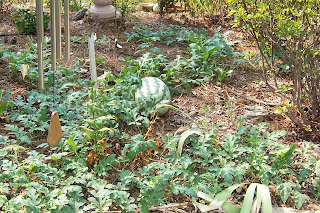
I wonder where gardeners get all of their plants? I was once asked that question and to tell you the truth I never really have thought about where all my plants have come from. I do know of course. When I moved into my house in August 2001 there were exactly five types of garden plants (excluding trees, pokeweed, poison ivy and the like). The five were: lily of the valley, purple irises, orange daylillies, pink sedum, and hostas. Those five types are all still with me but I have greatly expanded by purchasing the majority of my plants from big box stores, the next greatest source of plants for me comes from fellow gardeners, then from plant sales and garden shows and finally I do propagate some of my own plants.
My last blog entry spoke about why I garden and there is a great commercial out there that helps sum it up. Have you ever seen that Home Depot commercial where the woman moves into an apartment building with a dilapidated garden and says she began to garden with the help of Home Depot employees? At the end of the commercial she says something to the effect that "When you grow beautiful things then you are surrounded by beauty." Something like that. That commercial just makes me want to run to Home Depot for all of MY gardening needs. It really is a well done commercial. Many experienced gardeners talk about big box stores (Home Depot, Lowes and Wal-Mart) with disdain when it comes to purchasing plants but I think they are great places to buy plants. Most things for sale in these stores are industry approved varieties and are not real rare but that is ok. They will do fine and are priced very reasonably.
I have a story to share about Home Depot. When I first moved here we all went shopping at Home Depot. Being the gardener I am and anxious to get started I went straight to the garden center looking for some bargains. Back in 2001 Home Depot was selling Heucheras (common name Coral Bells) in six packs for about a buck and a half! That was such a great deal! I purchased a six pack or two. I still have those coral bells in my garden. They are the variety "Palace Purple" which I have never ever found for sale in a six pack since. Palace Purple generally sells for $3-4 per plant! I got each of mine for just 25 cents per plant! Coral Bells are great plants to grow in Tennessee. They are evergreen and low maintenance and perennial and are not picky about location though they prefer shade from the hot sun. The only drawback I have found is they sometimes get ratty looking by the end of summer. No matter, just cut back and clean up, water and wait for cooler weather to perk them up.
Yes, I do like big box stores and they serve their purposes for the greater majority of us very well. What are your feelings on big box stores and where do you obtain most of your plants when gardening? Write and let me know.
in the garden........






